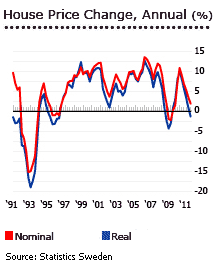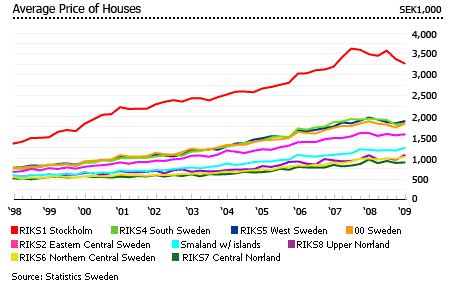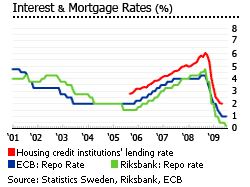Oh dear! Sweden's house price falls beginning!

House price rises in Sweden have been decelerating. During the year to end-Q2 2011, house prices increased by only 1.86%, according to Statistics Sweden. In fact, when adjusted for inflation, house prices actually dropped by 1.35% y-o-y to Q2 2011.
The cause? Sweden’s central bank has raised its key interest rate several times from a historic low of 0.25% in July 2010. The key rate is expected to reach 2.3% by end-2011.
On a quarterly basis, Swedish house prices rose by only 0.74% (-0.39% in real terms) in Q2 2011. Real estate prices are expected to drop further during the remainder of the year. "There is significant risk of a decline in house prices in coming years, even in a relatively benign economic scenario," the IMF noted recently.
However, the national figures conceal local house price variations. In Greater Stockholm, house prices rose by 2% y-o-y to Q2 2011. This was in contrast with Greater Malmo, which experienced a house price drop of 1% over the same period. Västerbotten (6% rise) and Västernorrland (5% rise) registered the highest house price increases. On the other hand, Jönköping (-5%) and Jämtland (-5%) experienced the largest price falls.
House prices in Sweden have been increasing since the mid-1990s as a result of the higher incomes, lower real interest rates and greater preference for housing consumption, according to the Sveriges Riksbank-Monetary Policy Department. Between 1996 and 2007, house prices soared by 217% (119% in real terms) in Greater Stockholm, 236% (185% in real terms) in Greater Malmo, and 202% (156% in real terms) in Greater Gothenburg.
After Greater Stockholm, house prices in South Sweden rose the most with a 185% (142% in real terms) increase from 1996-2007. The remaining three regions registered price increases ranging from 74% to 90%.
The shortage of housing supply in the country has helped push house prices up. The number of completed dwellings dropped 28.7% in 2009. In the first half of 2011, there were about 9,550 new multi-dwelling buildings under construction, up 8% from the same period last year, according to Statistics Sweden. On the other hand, the construction of one- to two dwelling units fell by 4% over the same period.
The 2008-2009 house price slump
Sweden’s decade long house price boom ended in 2008. This was a year of residential price falls, a significant decline in property sales, and an over-all slowdown of construction activity.
The price-falls were not extreme, however - the average price of houses in Sweden (one- and two- dwelling buildings) fell 2.9% (-3.7% in real terms) in the year to end-Q1 2009, to an average price of SEK1,830,000 (€166,018), according to Statistics Sweden.
In Greater Stockholm, the average price of houses fell by 6.3% in the year to end-Q1 2009 to SEK3,272,000 (€296,836). When adjusted for inflation, Greater Stockholm house prices were down by 7%.
The house price boom decade
Sweden’s house price boom started in mid-1990s, after the economy recovered from the financial crisis early in the decade. From 1996 to 2007, the price index for houses in Greater Stockholm soared 217% (119% in real terms). In Sweden’s two next largest urban areas, house prices rose 236% (185%) in Greater Malmo and 202% (156%) in Greater Gothenburg over the same period.

In five of Sweden’s eight regions, house prices doubled. After Greater Stockholm, prices in South Sweden rose the most with a 185% increase from 1996 to 2007 (142% in real terms). The remaining three regions registered price increases ranging from 74% to 90% with Central Norrland experiencing the lowest price rise.
Reasons cited for the house price boom include low interest rates, rapid economic growth and lack of new supply.
Transforming the Swedish model

Sweden has a mixed economy founded on public-private partnership. Its main features are centralized wage negotiation and a heavily tax-subsidized social security network. However this ‘Swedish model’ seemed at the end of the road by the late 1980s, and steps were taken to reduce the role of the state, resulting eventually in faster economic growth.
The country recovered gradually after an economic crisis hit the country in the early 1990s, when GDP contracted by an average of 1.4% from 1991 to 1993. The economy then grew by 3.9% in 1994 and 1995, and by an average of 2.6% from 1996 to 2003. From 2004 to 2007, GDP growth accelerated to an average of 3.5% annually.
This growth was mainly due to the rapid expansion of exports, which rose by 9.7% annually from 2004 to 2006. In 2008, exports accounted for 54% of GDP, with 60% of exports and 70% of imports going to the EU. Norway and the US are also significant trading partners.
Sweden’s economy is supported by a vibrant engineering sector which accounts for almost 50% of output and exports.
Private sector wages rose by an average of 4% annually from 1996 to 2007. Unemployment dropped to 4% in 2000-01, before rising to 5.8% in 2005. In 2007, it was down to 5.3%.
Not enough houses built

Housing construction declined from mid-1990s to early-2000s. This was partly because as a result of the free-market economic reforms, there was notable drop in dwellings built for social renting,
- Around 42,000 dwellings were completed annually from 1980 to 1990.
- From 1995 to 2001, less than 10,000 dwelling units were completed annually
- It was only in 2004 that dwelling completions again exceeded 20,000 units.
From 2004 to 2007, around 27,000 dwellings were completed yearly, still way below the level of completions in the early 1990s.
In 2008, completions reached 32,021 dwellings; 19,949 (62%) were in multi-dwelling buildings while 12,072 (38%) were in one or two-dwelling buildings.
Falling mortgage costs fueled the boom

With inflation stabilizing after 1995, interest rates for house purchase dropped from more than 10% during 1996 1H, to less than 5% during 2004 to 2008. Real interest rates dropped from 7% to 2%, partly due to stiff competition between housing credit institutions, banks and other financial institutions.
As a percentage of GDP, lending to households by housing credit institutions rose from 27% in 2000 to 43% in 2006. Lending to households by these institutions soared from SEK609 billion (€55 billion) in 2000, to SEK1.3 trillion (€120 billion) in 2008; an impressive 117% increase. Despite the credit crunch, housing credit institutions lending rose 15% y-o-y to reach SEK 1.89 billion ((€171 billion) in May 2009.
Tax reforms helped
Recently, radical reforms in property taxation have significantly reduced the costs of ownership, thus encouraging house-ownership.
> In 2006, taxes for owner-occupied housing and tenant-ownership associations and their members were reduced by about half of what would be required for neutrality, vis-à-vis other capital taxes and interest deductibility.
> In 2007, the tax on imputed housing rent was abolished, making ownership preferable to renting (imputed rent is assessed on a rent that is deemed whether the owner actually rented the unit out or not).
> In 2008, the real estate tax was replaced by a municipal fee of SEK4,500 (€481). On the other hand, the capital gains tax was raised from 20% to 30%.
The rental market is still distorted
However, these reforms have left the highly-regulated Swedish rental market largely untouched. Rent controls and high tax rates mean it is unprofitable for individuals to buy to rent. In 2002, 46% of dwelling stock was rented (24% social rental and 22% private rental), 38% owner occupied and 16% tenant-owned (housing cooperatives).
A large part of the rental sector is publicly-owned through property companies controlled at the municipal level. However, the number of municipal dwellings is being reduced at a faster rate than new units are established. Eight percent of the Swedish population is queuing for a new apartment, with an average waiting time of 10 years.
Lately, there has been a trend to convert public housing into private property. Nevertheless, quasi-ownership rights for tenants coupled with the legal design of lease contracts have barred the emergence of a proper rental market. Consequently, housing is bought for occupation, not for renting.
Rents in Sweden are largely historic cost-based, and reflect the age composition of the social housing stock. Swedish law requires that rent-setting be negotiated between tenant organizations and municipal housing companies (MHCs) or private landlord organizations. This led to rental yields that are relatively low and uncompetitive.
Private rents are compared to social housing rents, which leads to rent conformity across tenures. This rent-setting structure means that in attractive central urban locations, rents are often well below market levels. This limits the profitability of private rental markets. Therefore, the private rental sector has declined significantly over the past two decades.
Recent interest rate movements

Sweden’s house price boom slowed in 2008 due to interest rates hikes leading to a credit crunch. Swedish interest rates had followed the European Central Bank’s key interest rates upward. From the record low rate of 1.5% (in effect from July to December 2005), the Riksbank successively raised the repo rate to reach 3% in Dec 2006, 4% in Oct 2007 and 4.75% in September 2008. Each time the repo rate was raised by 25 basis points.
Housing credit institutions’ interest rates for house purchase rose steadily from 2.8% in Sept 2005 to 6.04% in September 2008 (due to a major change in the structure of interest rates in Sept 2005, earlier figures are not available).
The worst of the global financial meltdown was felt in Q3 2008, central banks started to ease monetary policies. Key interest rates started to fall during the last quarter of 2008; Riksbank’s key rate fell to 0.5% in April 2009 from the peak level of 4.75%. It was adjusted further to 0.25% in July 2009, its lowest level ever.
Lending rate of housing credit institutions for house purchase followed the key rate downward to 2.02% in May 2009. The lower lending rates in 2009 compared to Q4 2008 contributed to the relatively quick recovery of house prices.
Swedish households are particularly sensitive to interest rate hikes because majority of the loans are either a variable rate or fixed for less than 5 years. Generally, less than 20% of new housing loans approved since Aug 1999 have interests fixed for more than 5 years.
Severe recession in 2008-9

Sweden’s economy took a double hit in 2008. There was weak international demand for its products, and high interest rates at home, GDP contracted by 0.4%, down from 2.8% growth in 2007.
Sweden’s economy is expected to contract by another 5.5% in 2009, the worst economic performance in more than two decades. A slight recovery is expected in 2010 with 0.2% GDP growth.
In May 2009, the unemployment rate rose to 9%, from 6.4% in December 2008. Unemployment is expected to reach 11.1% in 2010, according to the Finance Ministry.
The weak domestic demand led to deflation of 0.4% in May 2009. The Riksbank expects prices will fall by an average of 0.2% during 2009.